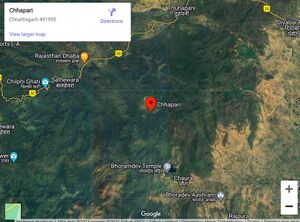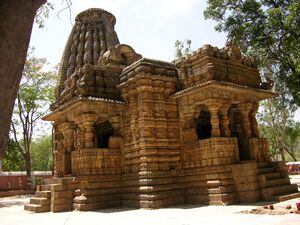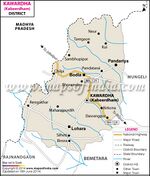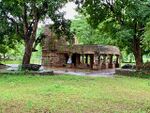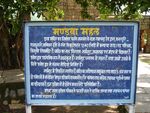Bhoramdeo
| Author:Laxman Burdak, IFS (R) |
Bhoramdeo (भोरमदेव) is a Temple complex dedicated to Shiva at Chaura village in Bodla tehsil of Kawardha district in Chhattisgarh. [1] It comprises a group of four temples of which the earliest is a brick-temple.[2] The Temple was built by Laxman Dev Rai & Gopal Dev of Phani Naga dynasty. Temple complex, highlighted as a "scintillating poetry in stone", is credited to Naga kings of Chakrakota, who ruled in the then South Kosala region, which is now the state of Chhattisgarh. Its construction is dated between the 7th and 12th centuries.[3] Chakrakuta is variant of Chitrakuta in Bastar[4], which was a Kingdom Nagavanshi Jats. [5] Fandi or Fanin Gotra Jats are descendants of Phani Naga. Author (Laxman Burdak) visited it on 16.04.1985 while on way from Raipur - Jabalpur.
Variants
- Bhoramdeo temple
- Bhoramdev (भोरमदेव)
- Mandava Mahal
- Madwa Mahal
- Bhauramdeo (भौरमदेव)
- Boramdeo
- Boramdeo temple
Origin
Jat Gotras Namesake
- Madwa = Madwa Mahal
- Fandi = Phani Naga
Location
It is situated 18 km to the North-West of the tehsil town of Kawardha in Kabirdham district.[6] There is also a bypass road from Raipur to Madhya Pradesh Highway which skirts the Kanha National Park.
History
The main temple is the Bhoramdeo temple built in stone. The architectural features with erotic sculptures has given a distinct style akin to the Khajuraho temple and the Konark Sun Temple in Odisha, and hence the Bhoramdeo complex is known by the sobriquet the "Khajuraho of Chhattisgarh".[7]
Another temple within a distance of about 1 km from Bhoramdeo, which is mentioned along with the Bhoramdeo complex is the Madwa Mahal, meaning marriage hall in local dialect, also known as Dullhadeo. It was built in 1349 during the reign of Ramchandra Deo of the Naga dynasty of Kawardha and has a unique Shiva Linga erected over 16 pillars.[8]
The temple complex, rich in history and archeological details, is dated to the Kalachuri period (10th-12th centuries, one ruling over areas in Central India in west Madhya Pradesh, Rajasthan and were called Chedi or Haihaya (Heyheya) (northern branch) with close identity with the sculptures found in nearby archeological sites such as Janjgir, Kalachuri, Narayanpur and Ratanpur sites. The brick temples were built during the rule of Pandus and are similar to those built in Kharod, Palari, Rajim and Sirpur in the state.[9]
The Temple was built by Laxman Dev Rai & Gopal Dev of Phani Naga dynasty. Temple complex, highlighted as a "scintillating poetry in stone", is credited to Naga kings of Chakrakota who practiced tantrism and who ruled in the then South Kosala region, which is now the state of Chhattisgarh. Its construction is dated between the 7th and 12th centuries.[10] As the Gond Tribals of the area worshiped Lord Shiva whom they called Bhoramdeo, the temple was also named Bhoramdeo with the Shiva Linga deified in it.[11]
Istaliq temple: The Istaliq temple or the temple built with dried or burnt clay bricks adjoins the main Bharamdeo temple. It was the first temple built between 2nd and 3rd centuries. This temple, in a dilapidated condition. It has only a sanctum sanctorum without an entrance hall or mantap. The tower above the sanctum sanctorum is extant only to half its height. There is wall projecting out of this temple which is known as "Allinda". Other existing structural features seen in the sanctum sanctorum are a few sculpted pillars. A sculpted Shiva Linga is deified here along with images of Uma Maheswar and of the king and queen standing in a worshipful pose.[12]
Cherki Mahal : Cherki Mahal, the last temple in the complex, is not easily locatable as it is situated in a thinly forested area. A Shiva Linga form, not carved is deified in this temple. The roof of the sanctum of the temple has lotus decoration. The entrance porch has many aesthetic repeated patterns.[13]
Madwa Mahal: Madwa Mahal, located about a kilometer away from the main temple, is a west facing temple where a Shiva Linga is deified. As the temple was built like a marriage hall or pandal (fabricated structure), known in local dialect as "Madwa". It was built in remembrance of the wedding of Nagavanshi king Ramachandra Dev and Haihaya vanshi Queen Raj Kumari Ambika Devi that took place in 1349.[14]
Entrance to the temple has traditional architectural embellishments. The ceiling of the entrance hall or mandapa had a dilapidated shikara, which has been remodeled crudely. However, the lowest part of this tower has many small erotic sculptures made by local artists. The entrance hall also has the usual feature of an image of Nandi (the bull) offering prayers to Shiva Linga, which is housed in the sanctum sanctorum. There is a stairway to approach the sanctum sanctorum from the main entrance.[15]
The external walls of this temple have 54 images in erotic sexual postures explained in the Kama Sutra, which are said to reflect the tantric culture practiced by the Nagawanshi kings.[16]
Bhoramdeo temple
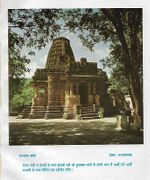
The Bhoramdeo temple is carved on the rocky stones in the Nagar style. This temple was built in the period of 7th to 11th century A.D.
The Shiva Linga in the temple is beautifully carved and the artistic appeal beckons the visitors. The Bhoramdeo temple has a resemblance with the Sun temple of Konark and The Khajuraho temple , and that is why it is also called the Khajuraho of Chhattisgarh. The “Madwa Mahal” near the Bhoramdeo temple is another beautiful historic monument, worth seeing. Just one km. away from Bhoramdeo , Madwa Mahal is known as the memorial of the marriage of Nagavanshi king and Haihawanshi Queen. ‘Madwa’ is a word from the local dialect synonymous to marriage pandal.
Madwa Mahal was originally a Shiva temple but due its shape, like a marriage shamiyana, it is known as “Madwa Mahal”. It is also called Dullhadeo. Nagavanshi emperor Ramchandra Deo has built it in 1349 A.D. The Shiva Linga is inside the ‘Garbha Grih’ and the ‘Mandap rests upon 16 pillars’.
The erogenous idols of this temple are also extremely beautiful. On the outer walls there are as many as 54 erotic sculptures in different poses. These asanas from the “Kam sutra”, are truly an epitome of eternal love and beauty. They are artistically significant too. The Nagavanshi Kings were believed to be the practitioners of ‘Trantra’ as their contemporaries in Khajuraho. The traces of turmeric on the walls, indicate that marriage and other rituals must have been performed here from time to time.
The Bhoramdeo temple, in the backdrop of natural beauty, is also unique for its architecture. Cunningham had termed it as one of the most beautifully decorated temple seen by him.
The main temple here has two parts. One is known as Ishtika made temple and the other is completely stone-carved. The main Bhoramdeo temple is in front of atranquil and cool lake. This medieval temple has been constructed upon a five feet high sprawling platform including a ‘Mandap’(shelter) Antral(Passage) and ‘Garbha Grih’(The main house of God). This east facing temple three openings except in the west. In the 60 ft. x 40 ft. area of the temple the Mandap which is square shape having four pillars in the centre and the rest are in periphery , associated with high roofs. There is a half shelter also on every entrance. In the 9 x 9 sq. ft sized ‘Garbha Grih’ a Shiva Linga’ is situated. The top of Grabha Grih goes straight to the summit of the temple known as the ”Kalash”. The east side Kalash is open in a circular form, probably to reduce the weight and maintain the balance of the structure. Near the entrance on the outer walls, the sculptures of Lord Vishnu and his other incarnations can be seen, besides those of Shiva, Ganesha etc. The row of idols from top to bottom have a size of one , one and half , and two feet height respectively The bottom part of the temple has four structures to keep the main body of the temple intact braving adverse weather condition. There are only four joints but no ‘kalash’ on the top of the same. The idols of elephants and lions are queued up on the top give the temple a decorative look. The main idols in the temple are those of Uma-Maheswar, Natraj , Narsimha , Vaman , Krishna, Surya , Kaal , Bhairava, Nritya Ganesh , Kartikeya, Tandul, Shivgang, Chamunda, Ambika, Sapta-Matrika and Laxmi-Naryan. The traces of 'Ram-Katha' are also engraved here in stones. Amidst a variety of idols the carnal sculptures of the temple are known worldwide for their exquisite carving in different erotic poses, obviously to reflect the lifestyle of those historic periods.In the north of the temple, there is a brick structure temple, which has got a superbly crafted series. On the North East and South portions of the ‘Garbha Grih’ the right angled projections add attraction to the site having big one in the middle and smaller ones on the outer side.
The brick-Structured temple also has similar Garbha Grih, as in main temple but there is no ‘Mandap’ in the front and only a open projected wall is there called ‘Allinda’. The top of this temple , too , is equal to the Bhoramdeo temple but the peak is broken mid-way. The entrance of the ‘Garbha Grih’ is completely stone-carved having one centre pillar and three adjoining pillars still intact. Inside the main temple there are shiva Linga and idols of Uma-Maheshwar. The king and queen are standing in the front as the worshippers.
Boramdeo Temple (Chhapri-Kawardha) Inscriptions 1088 A.D.
Near the village Chhapri, 11 miles east of Kawardha, there is an old temple of Vishnu, popularly known as Boramdeo, on account of Gonds having utilized it as a shrine of their god when they were ascendant. The oldest inscription here is on the pedestal of a large figure of a bearded man sitting with joined hands, which General Cunningham considered to be the Raja's religious adviser. There are four records on it. The first gives a number of names apparently of the temple builder's religious advisers. In the second inscription the names of his wife, sons and daughters are given, In the third the date is given as 840, during the reign of Gopaladeva, and the fourth gives the names of masons.
The year apparently belongs to the Kalachuri era, and is thus equivalent to 1088 A.D. Gopaladeva was evidently a local chief under the sovereignty of the Ratanpur kings. He may be identical with Gopaladeva of the Pujaripali inscription. The principal image of the temple is that of Lakshmi Narayana, on the pedestal of which the name of that ubiquitous Jogi Magaradhvaja with the figure 700 is inscribed. On the wall of the temple there is a modern inscription of the Samvat year 1608 (A. D. 1551), which was originally read as 160, equivalent to A.D. 103, and was quoted as a proof of the antiquity of Gond rule in Chhattisgarh.
Source - (Cunningham's Archaeological Reports, Volume XVIII, page 42.)
Mandava Mahal Inscription of Ramachandra of Phani Nagavanshi kings of Samvat 1406 (A. D. 1349) at Chaura
Source - Hira Lal: Descriptive lists of inscriptions in the Central provinces and Berar,p.162-63
Chaura is a village about 11 miles from Kawardha. In a temple known as Mandava Mahal (मंडवा महल) there is a long inscription on a slab containing 37 lines, which records the construction of a Siva temple by king Ramachandra, born of the Phani or Nagavansha, and married to Ambikadevi of the Haihaya lineage. It gives the legend of the origin of the Nagavansha, somewhat resembling that of the Haihaya-vansha, who claim a serpent and a mare to be their original ancestors. Our record relates that a serpent got enamoured of Mithila, the beautiful daughter of the sage Jatukarna (जाटुकर्ण).
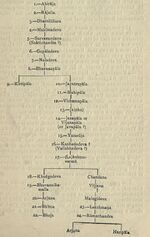
He therefore assumed human form and had intercourse with her. Their issue was Ahiraja, who, having conquered the neighbouring chiefs, set himself up as a king. The kings who followed him are shown in the genealogical table in the picture. Family tree is as under:
1. Ahiraja → 2. Rajalla → 3. Dharnidhara → 4. Mahimadeva → 5. Sarvavandana (Saktichandra ?) → 6. Gopaladeva → 7. Naladeva → 8. Bhuvanapala → 9. Kirtipala → 10. Jayatrapala → 11. Mahipala → 12. Vishamapala → 13. Ja(nhu) → 14. Janapala or Vijanapala (or Juvapala ?) → 15. Yasoraja → 16. Kanhadadeva ? (Vallabhadeva ?) → 17. (La)kshmavarma → 18. Khadgadeva → 19. Bhuvanaikamalla → 20. Arjuna → 21. -Bhima → 22. Bhoja
17. (La)kshmavarma → Chandana → Vijjana → Malugideva → 23 Lakshrtiana → 24. Ramachandra → (Arjuna + Haripala)
It would appear that the succession deflected twice from the direct line. For nine generations up to Kirtipala it went in a direct line. The 10th king Jayatrapala was a brother of Kirtipala, who apparently had no son to succeed him. Twelve descendants of Jayatrapala succeeded one after the other, the last king Bhoja being succeeded by Lakshmana, a great-grandson of his great-great-grand-uncle. Lakshmana's son was Ramachandra, the 20th descendant from the original ancestor Ahiraja.
The inscription is dated in Vikrama Saka 1406, bearing the name Jaya, which makes it clear that the year intended was that of the Vikrama era, as the cyclic year Jaya was current in Vikrama Samvat 1406 (A. D. 1349).
This record shows that Kawardha and the neighbouring country were under the sway of the Nagavanshi kings for a period of about 500 years, commencing from the beginning of the 9th Century A. D., a little before the advent of the Kalachuris or Haihayas to Chhattisgarh.
Apparently the Nagavanshis became the feudatories of the Kalachuris and continued to rule under their protection for a long time. Amongst the kings of this dynasty we find two names Gopaladeva (6) and Yasoraja (15) with which we are familiar from other inscriptions found in this locality. Gopaladeva's name occurs in the Boramdeo temple, about a mile away from our inscription slab. It is dated in the Kalachuri year 840, or A. D. 1088, while at Sahaspur, only 21 miles away from Chaura, there is a record of Yasoraja, dated in the Kalachuri year 934, or A.D. 1182. These kings must evidently belong to the dynasty which our record describes. Between Gopaladeva and Yasoraja there was an interval of only 94 years according to the dates of their inscriptions, but our record gives eight intervening generations, giving an average of less than 12 years to a generation. This throws a doubt on the accuracy of the genealogy, to swell which it is possible a number of fictitious names may have been inserted.
The geographical names mentioned in the record are Chavarāpura, the Samkari river, Rajapura and Kumbhipuri.
Chavarapura, to the east of which the temple was built, is undoubtedly the village Chaura, within whose limits the temple still lies, and Samkari is the Sankari river which is about a quarter of a mile away.
Rajapura was a village granted for the supply of offerings to the god, and may be identified with a village of the same name three miles from Chaura.
Kumbhipuri is not traceable. It was given at the same time as an agrahara to a Brahman named Mahesa.
The record which is in verse, was composed by a Dakshini Brahman Vitthala, which seems to account for the curious way in which he has indicated the era, calling it Vikrama Saka ; the last word Saka used in this phrase is merely an equivalent of a year.
भोरमदेव
भोरमदेव मंदिर छत्तीसगढ के कबीरधाम जिले में कबीरधाम से 18 कि.मी. दूर तथा रायपुर से 125 कि.मी. दूर चौरागाँव में एक हजार वर्ष पुराना मंदिर है।
मंदिर के चारोंं ओर मैकल पर्वतसमूह है जिनके मध्य हरी भरी घाटी में यह मंदिर है। मंदिर के सामने एक सुंदर तालाब भी है। इस मंदिर की बनावट खजुराहो तथा कोणार्क के मंदिर के समान है जिसके कारण लोग इस मंदिर को 'छत्तीसगढ का खजुराहो' भी कहते हैं। यह मंदिर एक एतिहासिक मंदिर है। इस मंदिर को 11वीं शताब्दी में नागवंशी राजा गोपाल देव ने बनवाया था। भोरमदेव , शिवजी का ही एक नाम है, जिसके कारण इस मंदिर का नाम भोरमदेव पडा।
निर्माण काल: मंदिर के मंडप में रखी हुइ एक दाढी-मूंछ वाले योगी की बैठी हुइ मूूर्ति पर एक लेख लिखा है जिसमे इस मूूर्ति के निर्माण का समय कल्चुरी संवत 8.40 दिया है। इससे यह पता चलता है कि इस मंदिर का निर्माण छठवे फणी नागवंशी राजा गोपाल देव के शासन काल में हुआ था। कल्चुरी संवत 8.40 का अर्थ 10 वीं शताब्दी के बीच का समय होता है।
कला शैली: मंदिर का मुख पूर्व की ओर है। मंदिर नागर शैली का एक सुन्दर उदाहरण है। मंदिर में तीन ओर से प्रवेश किया जा सकता है। मंदिर एक पाँच फुट ऊंचे चबूूतरे पर बनाया गया है। तीनों प्रवेश द्वारोंं से सीधे मंदिर के मंडप में प्रवेश किया जा सकता है। मंडप की लंबाई 60 फुट है और चौडाई 40 फुट है। मंडप के बीच में में 4 खंबे है तथा किनारे की ओर 12 खम्बे है जिन्होने मंडप की छत को संभाल रखा है। सभी खंबे बहुत ही सुंदर एवं कलात्मक है। प्रत्येक खंबे पर कीचन बना हुआ है। जो कि छत का भार संभाले हुए है। मंडप में लक्ष्मी, विष्णु एवं गरूड की मूूर्ति रखी है तथा भगवान के ध्यान में बैठे हुए एक राजपुरूष की मूर्ति भी रखी हुई है। मंदिर के गर्भगृह में अनेक मूर्तियां रखी है तथा इन सबके बीच में एक काले पत्थर से बना हुआ शिवलिंग स्थापित है। गर्भगृह में एक पंचमुखी नाग की मूर्ति है साथ ही नृत्य करते हुए गणेश जी की मूर्ति तथा ध्यानमग्न अवस्था में राजपुरूष एवं उपासना करते हुए एक स्त्री पुरूष की मूर्ति भी है। मंदिर के ऊपरी भाग का शिखर नहीं है। मंदिर के चारों ओर बाहरी दीवारों पर विष्णु, शिव चामुंडा तथा गणेश आदि की मूर्तियां लगी हैंं। इसके साथ ही लक्ष्मी विष्णु एवं वामन अवतार की मूर्ति भी दीवार पर लगी हुई हैं। देवी सरस्वती की मूर्ति तथा शिव की अर्धनारिश्वर की मुर्ति भी यहां लगी हुई है।
Gallery
References
- ↑ Syed Amanur Rahman; Balraj Verma (2006). The Beautiful India – Chhatisgarh. Reference Press.
- ↑ Deshpande, M.N. "Indian Archeological Survey – 1972-73" (PDF). National Informatics Center. pp. 13–14. Archived from the original (pdf) on 2016-03-04.
- ↑ Ramaswamy, Chitra (12 April 2012). "Sheer poetry in stone". The Hindu.
- ↑ Epigraphia Indica & Record of the Archaeological Survey of India, Vol.X, 1909-10, p.28
- ↑ Jat History Dalip Singh Ahlawat/Chapter III, p.242
- ↑ https://web.archive.org/web/20091125135517/http://kawardha.nic.in/bhoramdeo.htm
- ↑ https://web.archive.org/web/20091125135517/http://kawardha.nic.in/bhoramdeo.htm
- ↑ https://web.archive.org/web/20091125135517/http://kawardha.nic.in/bhoramdeo.htm
- ↑ Deshpande, M.N. "Indian Archeological Survey – 1972-73" (PDF). National Informatics Center. pp. 13–14. Archived from the original (pdf) on 2016-03-04.
- ↑ Ramaswamy, Chitra (12 April 2012). "Sheer poetry in stone". The Hindu.
- ↑ Ramaswamy, Chitra (12 April 2012). "Sheer poetry in stone". The Hindu.
- ↑ https://web.archive.org/web/20091125135517/http://kawardha.nic.in/bhoramdeo.htm
- ↑ https://web.archive.org/web/20140918172241/http://ganapati.perso.neuf.fr/anglais/achat/achat.html
- ↑ https://web.archive.org/web/20091125135517/http://kawardha.nic.in/bhoramdeo.htm
- ↑ https://upload.wikimedia.org/wikipedia/commons/2/23/History_of_Madwa_Mahal.jpg
- ↑ https://web.archive.org/web/20091125135517/http://kawardha.nic.in/bhoramdeo.htm
